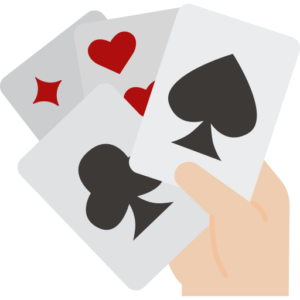Glossary Term
Inside Straight
Inside Straight
Used In: Poker
Introduction
An inside straight in poker refers to a hand that is one card short of a straight, where the missing card falls in the middle of the sequence. For example, if a player holds 4, 5, 7, and 8, they need a 6 to complete the straight. This is called an “inside” straight because only one specific rank can fill the gap, unlike an open-ended straight which has two possible cards to complete it.
The odds of completing an inside straight are relatively low. With one card to come, a player typically has four outs—the four cards of the needed rank remaining in the deck. Compared to drawing to an open-ended straight, which offers eight outs, the inside straight draw is less favorable. Because of this, most experienced players avoid relying on it unless the potential reward justifies the risk.
The term “drawing to an inside straight” has also become a figure of speech beyond poker. It often refers to taking a long shot or hoping for a very specific outcome with low odds. In poker, making this kind of draw is usually a sign of desperation or poor strategy, especially if it involves committing a lot of chips. Understanding this concept helps players make smarter decisions based on probability.
In Depth Look
An inside straight in poker is a hand where one specific card is needed to complete a five-card sequence, but that card must fill a gap in the middle. For example, if you hold 4♠, 5♦, 7♣, and 8♥, only a 6 will complete the straight—no other card helps. This differs from an open-ended straight draw, where a card on either end of the sequence can complete the hand. Because of this narrow requirement, inside straight draws are often considered weak drawing hands.
From a probability standpoint, drawing to an inside straight is a low-percentage play. If you’re waiting for one specific card out of the remaining 47 unseen cards (after the flop in Texas Hold'em), your chance of hitting it on the turn or river is about 8.5%. Compared to other draws, like flushes or open-ended straights, inside straight draws offer fewer outs and lower chances. This makes them a poor basis for big bets unless other factors, like position or implied odds, support the decision.
Strategically, most skilled players avoid chasing inside straights unless the cost to call is low and the potential reward is high. Betting heavily on a weak draw tends to lose money over time. However, there may be exceptions. If your opponent shows weakness, a semi-bluff with an inside straight draw could apply pressure. But as a general rule, playing inside straight draws requires caution and discipline.
Key points:
- An inside straight needs one specific middle card to complete a sequence.
- It offers only four outs, making it a low-percentage draw.
- Most strong players avoid betting big on inside straight draws unless the risk is minimal.
Mechanics
The mechanics of the fourth street begin after the “flop” round, where the first three community cards are dealt face-up. Once the betting for the flop has concluded, the dealer reveals the fourth community card, known as the “turn” or “fourth street.” All players still in the hand can see this card, and it’s placed face-up on the table alongside the flop. At this point, players use the fourth street along with their hole cards to evaluate their hands and make decisions based on the improved possibilities.
Following the reveal of the fourth street, a new betting round begins. Players can check, bet, raise, or fold, depending on how the fourth card affects their hand. If a player has made a strong hand or improved their hand, such as completing a straight or flush, they may decide to raise or bet for value. If the fourth street hasn't helped their hand, they may choose to check or fold. The betting continues until all players have either folded or matched the highest bet, and then the game proceeds to the fifth street, or “river,” where the final community card is dealt.


Illustrated Example
You're playing Texas Hold'em and are dealt 6♠ and 7♦. The flop comes 5♣, 9♥, and 8♠. Now, you have four cards that could form a straight: 5, 6, 7, and 8. To complete the straight, you need a 4 or a 10, right? Not in this case. Look closer—your cards create a gap in the middle. You’re missing a 5-card sequence because there's no 4 or 10 that connects directly to all your cards. The only card that completes the straight is a single 9—this is a classic example of an inside straight draw.
Players often misread hands like these and overestimate their chances. In this example, the only card that helps you is a 9, and since four nines exist in the deck, you have just four outs. That means you have about an 8.5% chance of hitting a 9 on the turn if you’re only drawing one card. Calling a large bet here might not be worth it unless you expect to win a big pot if the 9 hits, or if you're planning to bluff on later streets.
Understanding the difference between inside and open-ended draws can help avoid costly mistakes. Many beginner players chase these low-odds hands and end up losing more in the long run. Knowing your outs—and your chances—helps make smarter, more disciplined decisions at the table.
| Street | Cards | Description |
|---|---|---|
| Hole Cards | 6♠, 7♦ | Your starting hand |
| Flop | 5♣, 8♠, 9♥ | Board cards—create a potential straight |
| Needed Card | 9♦, 9♣, 9♠, 9♥ | Only the 9 completes the straight (inside draw) |
| Outs | 4 | Four cards left in the deck that can help |
| Odds (1 card to come) | 8.5% | Chance of hitting your card on the turn |
Player Perspective
From the player’s perspective, holding an inside straight draw often creates a tough decision. The hand feels close to something strong, but the odds don’t support aggressive play. Many players are tempted to chase the draw, especially if the pot is large or their opponents seem uncertain. However, experienced players learn to evaluate the situation carefully—considering pot odds, position, stack size, and opponent tendencies—before deciding whether to continue.
A disciplined player views the inside straight as a potential, not a promise. They understand that four outs give them limited chances, and unless the reward outweighs the risk, folding is usually the right move. That doesn’t mean the hand has no value—sometimes it can be used for a bluff, especially if the draw adds pressure to opponents. But overall, players who rely on math and timing rather than hope tend to handle inside straight situations more effectively.
Conclusion
In poker, recognizing and properly evaluating an inside straight draw is a key part of sound decision-making. While the potential payoff can be tempting, the low odds make it a risky play without the right conditions. Smart players don’t chase these draws blindly—they weigh the cost, consider the context, and act with discipline. Understanding the true value of an inside straight helps avoid costly mistakes and builds a more consistent, long-term strategy at the table.
The Top Online Casinos for Playing Poker
These platforms prioritize player satisfaction by providing intuitive interfaces, seamless gameplay experiences, and robust security measures to ensure a fair and enjoyable environment for all users.


Author
Branimir Ivanov | Senior News Contributor







